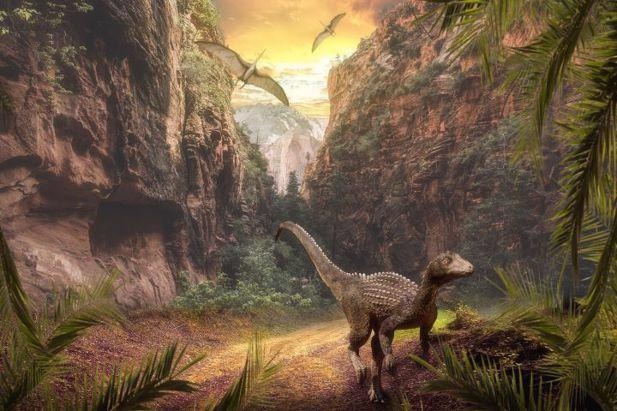A new study discloses that the increase of dinosaurs corresponded with environmental changes induced by significant volcanic eruptions over 230 million years ago.
 Ecological changes following intense volcanic activity 230 million years ago paved the way for dinosaur dominance. Image Credit: University of Birmingham.
Ecological changes following intense volcanic activity 230 million years ago paved the way for dinosaur dominance. Image Credit: University of Birmingham.
The Late Triassic Carnian Pluvial Episode (CPE) evidenced a rise in global humidity and temperature. This led to a considerable impact on the development of plant and animal life, coinciding with the creation of modern conifers.
The sediment and fossil plant records gathered from a lake in northern China’s Jiyuan Basin were examined by scientists. This matched pulses of volcanic activity with considerable environmental variations, such as the CPE’s “mega monsoon” climate, some 234 million to 232 million years ago.
The international research group, which included experts from the University of Birmingham, has recently reported the study findings in Proceedings of the National Academy of Sciences (PNAS).
The study unravels four different episodes of volcanic activity during this time period, with the most probable source being significant volcanic eruptions from the Wrangellia Large Igneous Province, the remains of which are retained in western North America.
Within the space of two million years the world’s animal and plant life underwent major changes including selective extinctions in the marine realm and diversification of plant and animal groups on land. These events coincide with a remarkable interval of intense rainfall known as the Carnian Pluvial Episode.
Jason Hilton, Study Co-Author and Professor of Palaeobotany and Palaeoenvironments, School of Geography, Earth and Environmental Sciences, University of Birmingham
“Our research shows, in a detailed record from a lake in North China, that this period can actually be resolved into four distinct events, each one driven by discrete pulses of powerful volcanic activity associated with enormous releases of carbon dioxide into the atmosphere. These triggered an increase in global temperature and humidity,” added Hilton.
The scientists discovered that every phase of volcanic eruption coincided with major climatic changes to more humid conditions, huge perturbation of the global Carbon cycle, as well as the deepening of the lake with an equivalent decrease in oxygen and animal life.
Geological events that took place in a similar timeframe in East Greenland, Central Europe, North America, Morocco and Argentina, besides other locations, denote that increased rainfall led to the extensive expansion of drainage basins converging into swamps or lakes, instead of oceans or rivers.
Our results show that large volcanic eruptions can occur in multiple, discrete pulses — demonstrating their powerful ability to alter the global carbon cycle, cause climate and hydrological disruption and drive evolutionary processes.
Dr. Sarah Greene, Study Co-Author and Senior Lecturer, School of Geography, Earth and Environmental Sciences, University of Birmingham
According to Dr. Emma Dunne, a Palaeobiologist also from the University of Birmingham, who was not part of the study, “This relatively long period of volcanic activity and environmental change would have had considerable consequences for animals on land. At this time, the dinosaurs had just begun to diversify, and it’s likely that without this event, they would never have reached their ecological dominance we see over the next 150 million years.”
In addition to dinosaurs, this remarkable period in Earth history was also important for the rise of modern conifer groups and had a major impact on the evolution of terrestrial ecosystems and animal and plant life — including ferns, crocodiles, turtles, insects, and the first mammals.
Jason Hilton, Study Co-Author and Professor of Palaeobotany and Palaeoenvironments, School of Geography, Earth and Environmental Sciences, University of Birmingham
The researchers examined terrestrial sediments from the ZJ-1 borehole in the Jiyuan Basin of North China. Through high-resolution chemostratigraphy, uranium-lead zircon dating, palynological and sedimentological data, they compared terrestrial conditions in the region with concurrent large-scale volcanic activity in North America.
Journal Reference:
Lu, J., et al. (2021) Volcanically driven lacustrine ecosystem changes during the Carnian Pluvial Episode (Late Triassic). Proceedings of the National Academy of Sciences. doi.org/10.1073/pnas.2109895118.